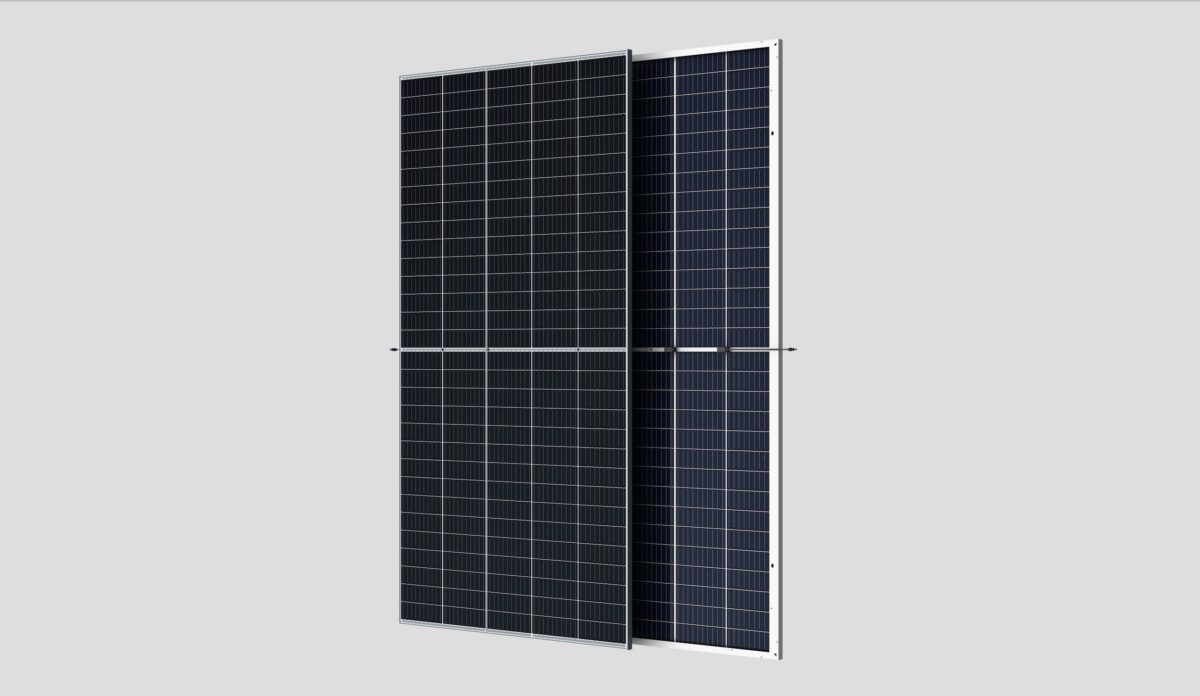Chinese panel maker Trina Solar, formerly Australia’s largest module supplier, has launched two new PERC monocrystalline bifacial solar modules, each with a reported power output of 500 W.The Duomax V has a glass-glass structure and the Tallmax V features a glass-backsheet frame.
pv magazine Australia spoke to Trina solar senior country sales manager for Australia, New Zealand and the Pacific Govind Kant, who said the significance of the 500 W milestone is in Trina Solar’s determination not only to develop new technologies, but to bring those innovations to the market at a large scale.
Trina reports a conversion efficiency of 21% for each product, due largely to the ‘large-format’ silicon wafers of cells 210mm in diameter, and the manufacturer’s multi-busbar technology. Govid described these higher power modules as a “game changer.”
The changing game comes down to the delivery of lower balance of system (BOS) costs. The modules require fewer mounting systems and, therefore, less material and less labour. Of course, to make these savings meaningful, the modules need to be utilised at utility-scale or commercial or industrial (C&I), which is to say, at least 1MW or more.
According to Trina Solar preliminary estimates from large-scale ground-mounted power stations in China’s Heilongjiang province, the 500 W Duomax V is capable of reducing BOS costs by 6%-8% when compared to the conventional 410 W bifacial double-glass modules, and the levelised cost of energy (LCOE) by 3%-4%.
Govind is confident the significant BOS and LCOE savings are even more valuable in Australia than in China, after all, “labour costs are higher in Australia than China.” “Therefore,” continued Govind, “in the Australian context, the labour costs savings – achieved from using 500 W modules – would have an even greater impact on BOS. Manhours are less for installation of 500 W modules, because each module has more power capacity.”

Image: Trina Solar
Bifacial Uptake
The 500 W mark itself refers only to the front-side power. The bifacial module delivers even more power, indeed anywhere between 5%-30% more power can be delivered from the backside sheet.
“We are already seeing a shift to bifacial in Australia,” observes Govind, “The technology makes a lot of sense for utility-scale projects.” Govind concedes that bifacial has been slow to take off in Australia due to developer anxiety over modelling and financial returns, but believes anxiety has dissipated in accordance with more bifacial projects coming online.
The other major factor in bifacial take up is, of course, the dropping price. “The price gap between bifacial and mono-facial are at a level that the energy yield benefits and BOS savings exceeds the cost premium,” continued Govind. “Bifacial modules become a preferred choice for customers, because even if you are only getting a few percentage-point gains in efficiency, you are still ahead in terms of dollar per kilowatt hours you will get from your system.”
Surprisingly, C&I uptake of bifacial is also on the rise. “We are currently installing some modules (bifacial) on rooftops of supermarkets in Australia,” said Govind. The facilitation of this uptake is part of a wider trend in the PV industry, that of system integration. One of the hurdles bifacial struggled with was that the performance of the rear module depends on multifarious factors which are difficult to guarantee. However, system integration, helped by tools like Trina Solar’s Trina Pro, ensure the module, trackers, mounting system and inverters interact symbiotically under the one integrated umbrella.
Trina Solar vice general manager and executive vice president Yin Rongfang said, “We hope to drive the standardisation of modules through our design and manufacturing advantages, which will not only benefit many segments in the industrial chain, but also enhances the design commonality of modules on the system side.” Yin added, “I believe our new modules will bring the photovoltaic market to the next stage.”
Utility-Scale Innovation Meets Utility-Scale Congestion
BOS reductions in the rage of 6%-8% for utility-scale projects represents a significant saving, but congestion anxiety in Australia is a growing concern as more large-scale projects get dammed up in the congested pipeline.
The impediment before the development of utility-scale projects in Australia is the need for more investment in grid infrastructure, says Govind. BOS savings for utility-scale products are cause for enthusiasm, but only if investors and developers are confident they can get their project built.
Network conditions have continued to deteriorate around Australia as anachronistic infrastructure fails to cooperate with the new century of energy. Congestion has become such a cause of frustration that the Victorian Government has now decided to break away from national electricity rules. The Andrews Government introduced legislation to fast-track priority projects and transmission upgrades to ensure large-scale renewables can more easily connect to the grid.
Clean Energy Council CEO Kane Thornton said, “Our transmission network has simply not kept pace with the transition to a 21st-century energy system and is causing major concerns for investors in clean energy.” Thornton added, “Over the last year we have seen a massive 50% decrease in large-scale renewable energy investment,” continued Thornton, “and we know that the lack of investment in transmission is the single biggest factor preventing the deployment of new generation projects.”
Last September, AEMO constrained the output of five large-scale solar generators by 50%, including four solar farms located in north-west Victoria: Gannawarra, Karadoc, Wemen and Bannerton; and Broken Hill in NSW. NEM-wide solar and wind curtailment reached a record high of 6% of total output in Q4 2019, according to AEMO data. This happened mainly due to self-curtailment in response to negative prices, system security constraints on five solar farms in Victoria and NSW, system strength constraints in South Australia, and transmission outages and other network constraints.
The Cell and the Cut:
Trina claims to have created an innovative cell design combining advanced third-party devices, a non-destructive cutting process and high packing density. According to Govind, cutting the cell into three uniform pieces produces a smoother cutting surface with no cracks compared to the traditional half-cut technology.
The modules are already available to order in Australia with deliveries set to begin in 2020’s third quarter.
This content is protected by copyright and may not be reused. If you want to cooperate with us and would like to reuse some of our content, please contact: editors@pv-magazine.com.









1 comment
By submitting this form you agree to pv magazine using your data for the purposes of publishing your comment.
Your personal data will only be disclosed or otherwise transmitted to third parties for the purposes of spam filtering or if this is necessary for technical maintenance of the website. Any other transfer to third parties will not take place unless this is justified on the basis of applicable data protection regulations or if pv magazine is legally obliged to do so.
You may revoke this consent at any time with effect for the future, in which case your personal data will be deleted immediately. Otherwise, your data will be deleted if pv magazine has processed your request or the purpose of data storage is fulfilled.
Further information on data privacy can be found in our Data Protection Policy.